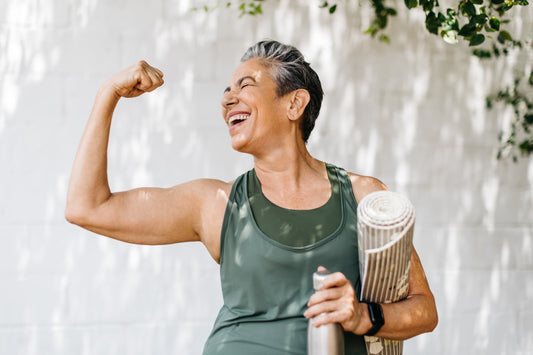Vitamin deficiencies are surprisingly common, leading to side effects like brain fog, low energy, mood changes, and more. Here are the 6 women’s vitamins to consider.
Finding it hard to stay focused and on task? Experiencing dizzy spells, losing your balance more often, or feeling chronically low on energy? Most of us are quick to chalk these sorts of odd symptoms up to a bad night's rest or stress. And while these are also fair culprits to consider, we often forget another common source of these symptoms: vitamin deficiencies.
Research by Unicef reports that as many as 70% of women and girls worldwide - that's about 1.2 billion people - live with vitamin deficiencies.1 Research also suggests that the risks of these deficiencies can increase as we age. When we zoom in on the American diet, key nutrients like folate, vitamin D, calcium, and iron are often missing from the foods we eat.
In this blog, we'll go over the 6 key vitamin deficiencies women are most susceptible to, common signs to look out for, your recommended daily amounts, and where to find them in your diet and supplements.
#1 Iron
Iron makes up part of a protein called hemoglobin, which lives in red blood cells and helps transport oxygen throughout the body. Women are naturally more prone to deficiencies due to the blood loss that happens during the menstrual cycle.
Studies estimate around 30% of women (of reproductive age) are low on iron. One study found as many as 40% of women from 12 to 21 years old were deficient in iron. 2
According to Yale School of Medicine's Dr. Van Doren, many iron deficiency symptoms without anemia are "nonspecific and vague." This can make them easy to dismiss until they build up over time.
Common iron deficiency symptoms include:
- Chronic exhaustion and fatigue (even after a good night's rest)
- Digestive issues
- Restless legs
- Persistent brain fog
- Poor mood
- Thinning hair
- Brittle or thinning nails
How much iron per day for a woman (RDA):
- Women 14 to 18: 15 mg
- Women 19 to 50: 18 mg
- Pregnant women: 27 mg
- Women 50+: 8 mg
Iron-rich foods to add to your next grocery trip: 3
- Fortified cereals or whole grains
- Oysters
- Mussels
- Duck
- Sesame seeds
- Artichoke
- Spinach
- Lima beans
*It's important to note that different food combinations can affect how your body absorbs iron. Eating foods high in calcium at the same time as iron-rich foods decreases iron absorption. On the other hand, foods high in vitamin C increase the body's absorption of iron.
#2 Vitamin B12
Vitamin B12 is essential for some of your body's most critical functions: forming red blood cells, synthesizing DNA, supporting nerve function, and converting food into energy. Women face higher risks of B12 deficiency, particularly alongside certain medical conditions like autoimmune disorders or Crohn's Disease. 4
Research suggests between 6-18% of women are B12 deficient. The risk increases for those over 50, pregnant women, strict vegetarians or vegans, those recovering from surgery, and people with certain autoimmune conditions. 5, 6
Common vitamin B12 deficiency symptoms in women include:
- Anemia
- Dry skin
- Brain fog
- Exhaustion
- Muscle weakness
- Changes in mood
- Trouble with balance
- Tingling in extremities
Recommended daily amounts:
- Women 14+: 2.4 mcg/day
- Pregnant women: 2.6mcg/day
Vitamin B12-rich foods to add to your next grocery trip:
- Organ meats (liver, kidney)
- Eggs
- Beef
- Clams
- Sardines
- Dairy products
- Fortified cereals and non-dairy milk
#3 Vitamin D

Vitamin D supports your body's ability to absorb calcium and phosphorous, making it essential for bone health. Vitamin D is also critical for immune system health, and other key functions throughout the body. This deficiency often stems from limited sun exposure, certain medications, or conditions affecting liver or kidney function.
Recent studies show the average daily vitamin D intake for women in the US is about 4.2 mcg — significantly below the recommended 15 mcg. While sunlight can help bridge this gap, many still need supplementation. Risk factors increase for older adults, those with limited sun exposure, and individuals with health conditions that affect absorption and lead to lower vitamin D levels.7, 8
Common vitamin D deficiency symptoms in women include:
- Brittle bones
- Risk of bone fractures
- Muscle weakness and pain
- Increased risk of bone pain
- Increased sensitivity to pain
- Muscle spasms, twitches, or tremors
- Increased risk of falls for older adults
- Numbness or "pins and needles" feeling in feet or hands
Recommended daily amounts:
- Women 14 to 18: 15 mcg (600 IU)
- Women 19+: 15 mcg (600 IU)
- Pregnant women: 15 mcg (600 IU)
Vitamin D-rich foods to add to your next grocery trip:
- Egg yolks
- Fatty Fish (with skin)
- Fish liver oils
- Fortified milk and cereal
- White mushrooms (treated with UV light)
*Important note: Diet alone might not be enough to restore balance if you have a deficiency. Your healthcare provider may recommend a high dose to prevent long-term health problems and bring your vitamin D levels back into balance.
#4 Calcium
While it's best known for supporting bone and teeth health, calcium also maintains tissue tone for movement and plays crucial roles in blood vessel function, clotting, muscle function, hormones, and nerve signaling. About 98% of your body's calcium is stored in your bones.
The numbers tell an interesting story: women start life with 26-30g of calcium, reaching about 1,200g in adulthood. However, levels typically drop during menopause as estrogen decreases. Age also affects how well we absorb calcium — starting at 60% absorption in young children but dropping to about 25% in adulthood and continuing to decline.
Interestingly, there's an inverse relationship with intake: at 200 mg/day, your body absorbs around 45%, but this drops to just 15% at 2,000 mg/day.9
Common calcium deficiency symptoms include:
- Muscle weakness, cramps, spasms, aches
- Thigh and/or arm pain when moving
- Tingling or numbness in the extremities and around the south
- Extreme fatigue
- Reduced bone strength
- Osteoporosis
- Fragile bones
- Increased risk of falling
- More severe PMS symptoms
- Mood shifts
Recommended daily amounts:
- Women 14 to 18: 1,300 mg
- Women 19 to 50: 1,000 mg
- Women 50+: 1,200 mg
- Pregnant women: *defer to age range
Vitamin calcium-rich foods to add to your next grocery trip:
- Yogurt
- Fortified orange juice
- Milk
- Cheese
- Canned sardines
- Salmon with bones
- Broccoli
- Kale
- Bok choi
- Fortified grains and cereals
#5 Folate
Folate, a crucial B vitamin, helps your body create new healthy red blood cells and prevent anemia. It's particularly vital before and during pregnancy — protecting against serious birth defects that can occur in the first few weeks before many women know they're pregnant.
The stats suggest that - among women aged 12-49 who weren't pregnant - 22.8% had suboptimal folate concentrations.11, 12
Common folate deficiency symptoms include:
- Fatigue
- Gray hair
- Irritability
- Peripheral neuropathy
- Swelling of tongue and mouth sores
How much folate should a woman consume (RDA):
- Women 18+: 400 mcg
- Pregnant women: 400-800 mcg
*You should eat no more than 1,000 mcg a day unless your doctor prescribes that amount.
Vitamin folate-rich foods to add to your next grocery trip:
- Spinach
- Green leafy vegetables
- Brussel sprouts
- Broccoli
- Bananas, melons
- Orange juice
- Nuts
- Beans
- Fortified pastas, breads, and cereals
- Chicken
- Turkey
#6 Iodine
Iodine might not be the first nutrient you think about, but it's essential for making thyroid hormones that regulate metabolism, brain function, and bone development.
Women are particularly susceptible to iodine deficiency: 16-36% of women of reproductive age have lower than healthy iodine levels, with some studies reporting rates as high as 40%. This deficiency can have wide-ranging effects on energy, metabolism, and cognitive function.13
Common iodine deficiency symptoms include:
- Fatigue
- Muscle weakness
- Swollen thyroid glands or a visible lump on the neck
- Weight gain
- Dry skin and thinning hair
- Cognitive difficulties (learning, memory)
Recommended daily amounts:
- Women 14+: 150 mcg
- Pregnant women: 220 mcg
Iodine-rich foods to add to your next grocery trip: 14
- Eggs
- Dairy products
- Seaweed
- Enriched breads
- Baked cod
- Oysters
Not all Supplements are Made Equal!

Supplements aren't regulated by the FDA like medications are. That means quality can vary significantly. Take melatonin, for example — a recent study found doses ranged from 83% below to 400% above what was listed on the label. Some supplements were even found to contain unlisted ingredients, including CBD and serotonin.15
When looking for the best vitamins for women, check that they've undergone third-party testing for quality assurance. Additionally, please make sure to consult your primary care provider before making big shifts to your diet or beginning new supplements, especially if you're taking other medications.
References:
- Buechner, M., & Fox, K. (2023, March 14). Undernourished and Overlooked: New Report Reveals Global Nutrition Crisis for Women and Girls. UNICEF USA. https://www.unicefusa.org/stories/undernourished-and-overlooked-new-report-reveals-global-nutrition-crisis-women-and-girls
- Katella, K. (2024, September 12). Are You Iron Deficient? 8 Things Women Should Know. Yale Medicine. https://www.yalemedicine.org/news/are-you-iron-deficient-what-women-need-to-know
- Food Sources of Iron | Dietary Guidelines for Americans. (2020). Dietaryguidelines.gov. https://www.dietaryguidelines.gov/resources/2020-2025-dietary-guidelines-online-materials/food-sources-select-nutrients/food-sources-iron
- Katella, K. (2024, June 26). Are You Getting Enough Vitamin B12? What You Need to Know. Yale Medicine; Yale Medicine. https://www.yalemedicine.org/news/are-you-getting-enough-vitamin-b12
- Al-Musharaf, S., McTernan, P. G., Hussain, S. D., Aleisa, K. A., Alnaami, A. M., Wani, K., Saravanan, P., & Al-Daghri, N. (2020). Prevalence and Indicators of Vitamin B12 Insufficiency among Young Women of Childbearing Age. International Journal of Environmental Research and Public Health, 18(1), 1. https://doi.org/10.3390/ijerph18010001
- Margalit, I., Cohen, E., Goldberg, E., & Krause, I. (2018). Vitamin B12 Deficiency and the Role of Gender: A Cross-Sectional Study of a Large Cohort. Annals of Nutrition and Metabolism, 72(4), 265–271. https://doi.org/10.1159/000488326
- Yale Medicine. (2024). Vitamin D Deficiency. Yale Medicine. https://www.yalemedicine.org/conditions/vitamin-d-deficiency
- National Institutes of Health. (2024, July 26). Vitamin D. National Institutes of Health. https://ods.od.nih.gov/factsheets/VitaminD-HealthProfessional/
- NIH. (2022). Calcium. Nih.gov. https://ods.od.nih.gov/factsheets/Calcium-HealthProfessional/
- Barhum, L. (2020, December 7). Calcium deficiency disease (hypocalcemia): 7 symptoms and causes. Www.medicalnewstoday.com. https://www.medicalnewstoday.com/articles/321865#consulting-a-doctor
- Folic acid | Womenshealth.gov. (2019, April). Womenshealth.gov. https://www.womenshealth.gov/a-z-topics/folic-acid
- Tinker, S. C., Hamner, H. C., Qi, Y. P., & Crider, K. S. (2015). U.S. women of childbearing age who are at possible increased risk of a neural tube defect-affected pregnancy due to suboptimal red blood cell folate concentrations, National Health and Nutrition Examination Survey 2007 to 2012. Birth Defects Research Part A: Clinical and Molecular Teratology, 103(6), 517–526. https://doi.org/10.1002/bdra.23378
- Panth, P., Guerin, G., & DiMarco, N. M. (2019). A Review of Iodine Status of Women of Reproductive Age in the USA. Biological Trace Element Research, 188(1), 208–220. https://doi.org/10.1007/s12011-018-1606-5
- National Institutes of Health. (2022). Office of Dietary Supplements - Iodine. Nih.gov. https://ods.od.nih.gov/factsheets/Iodine-HealthProfessional/
- Study finds that melatonin content of supplements varies widely. (2017, February 14). American Academy of Sleep Medicine – Association for Sleep Clinicians and Researchers. https://aasm.org/study-finds-that-melatonin-content-of-supplements-varies-widely/



